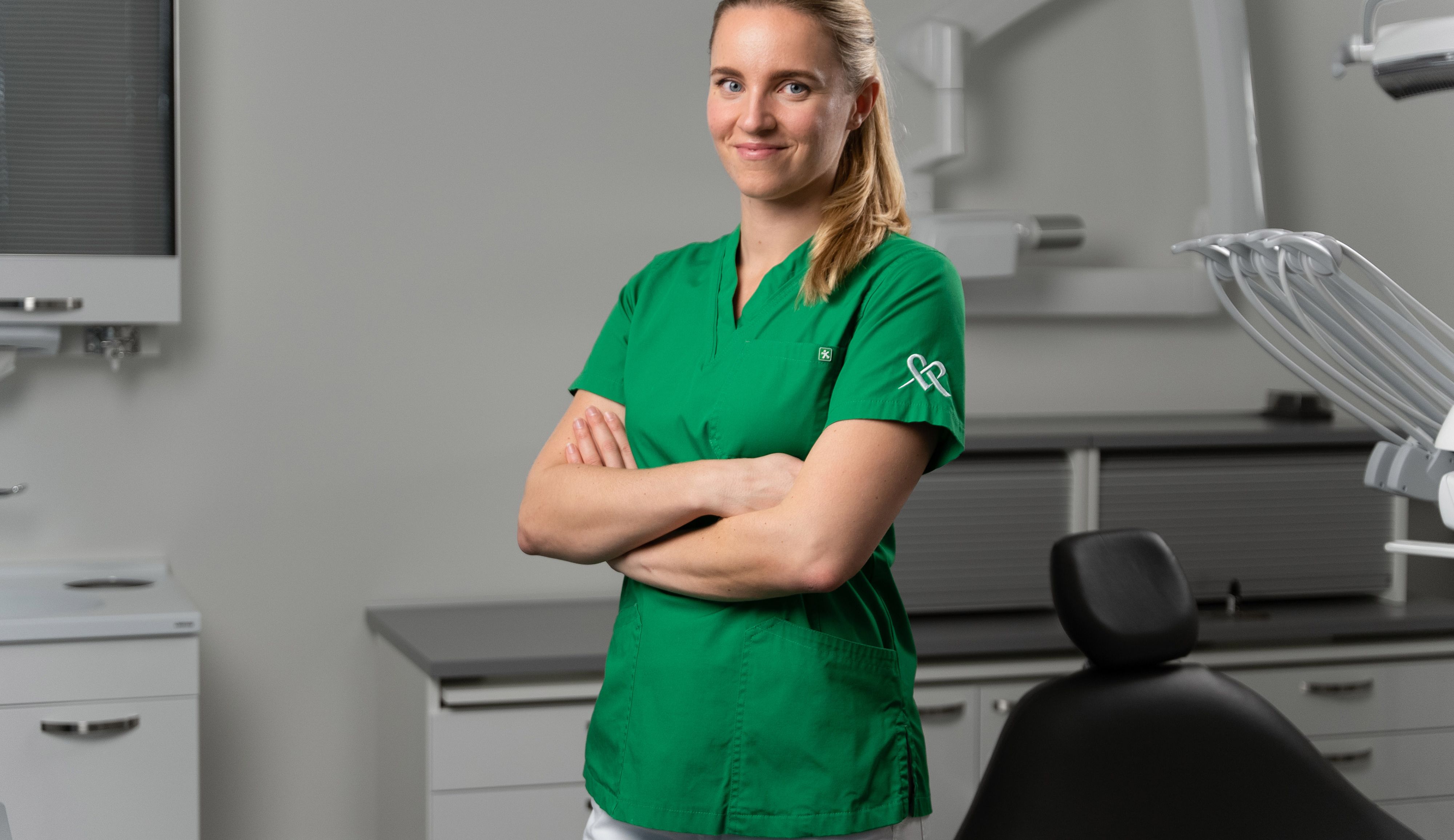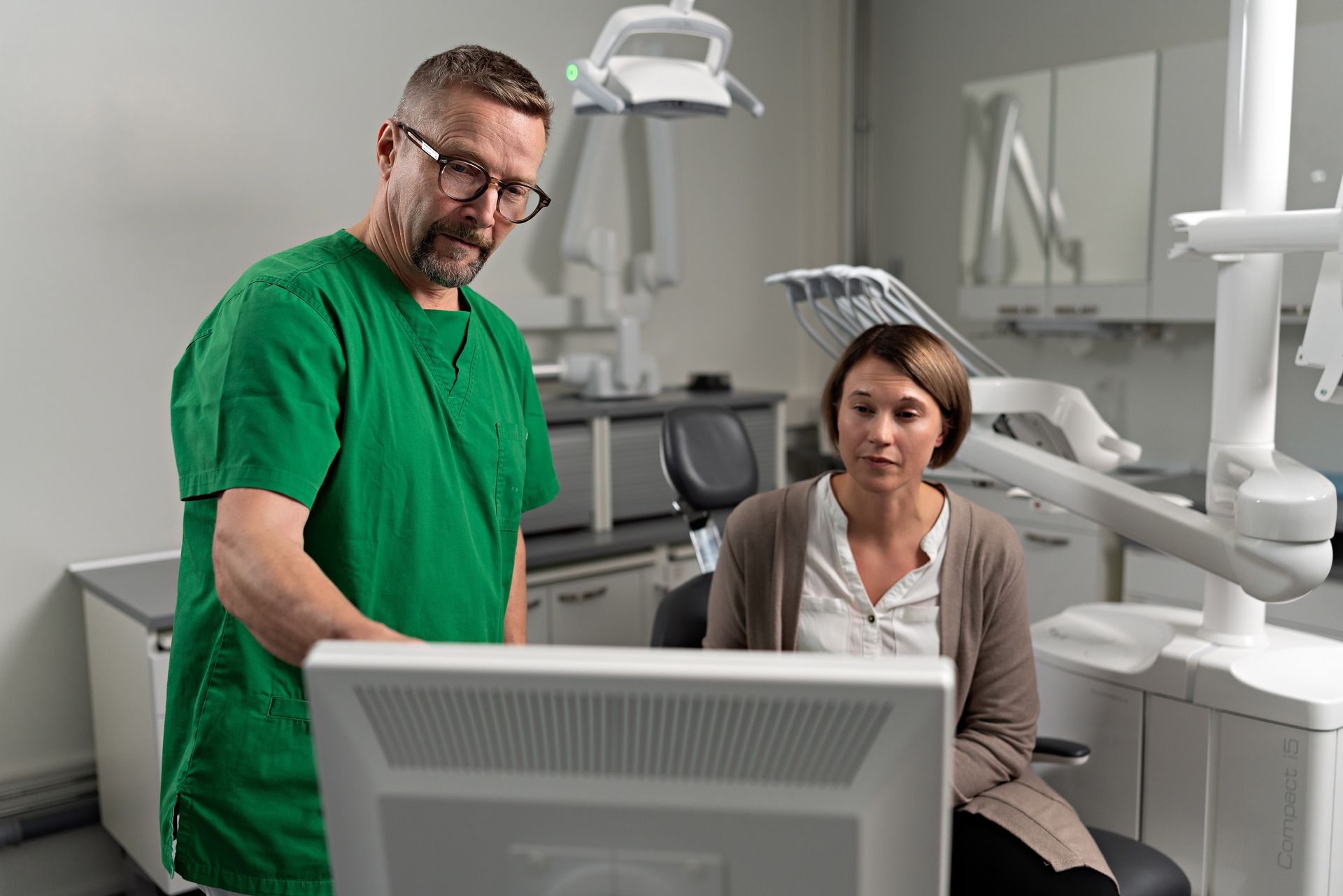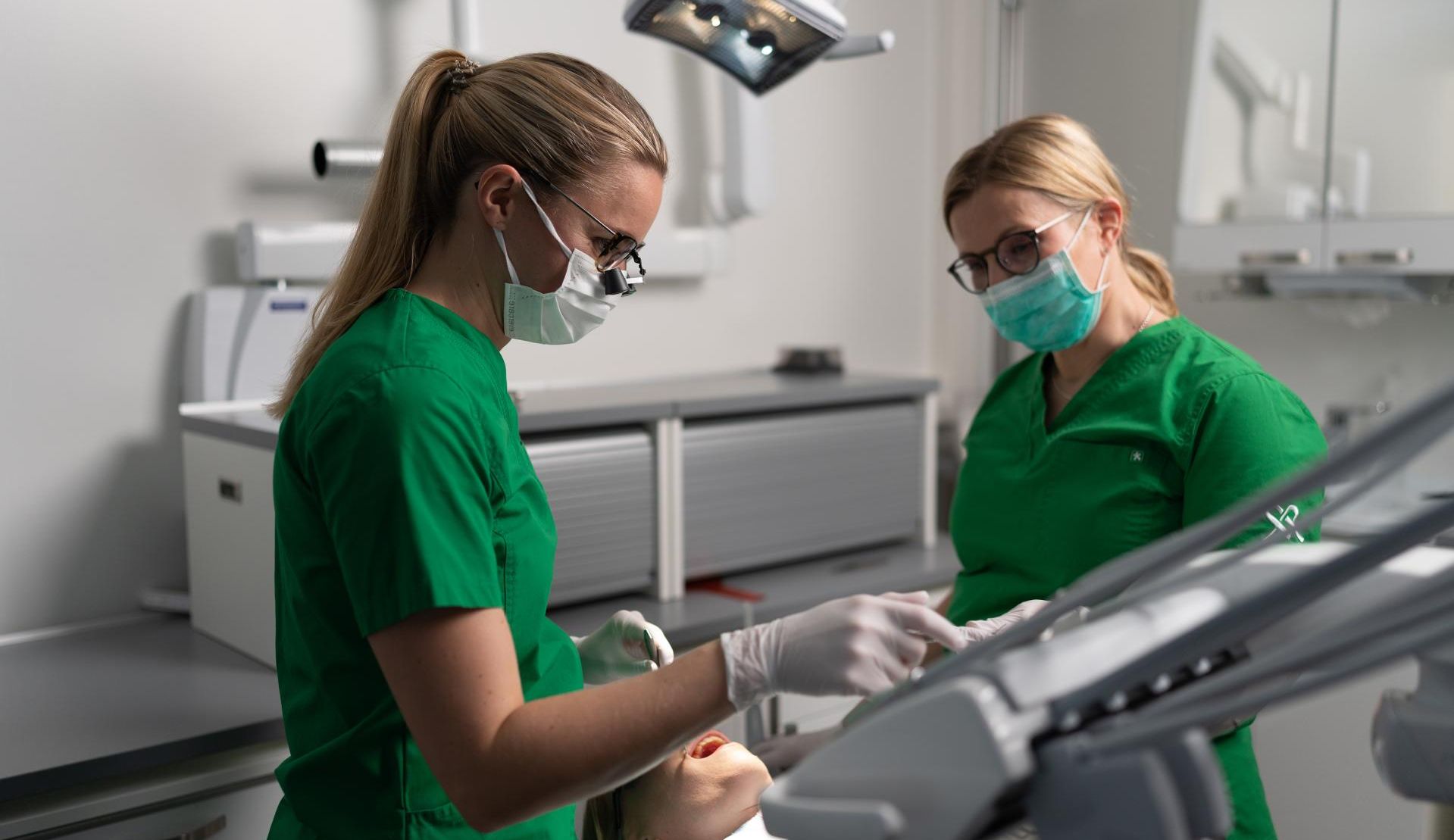
Dental fear is common - We will be there for you
Pay flexibly with various payment methods. Learn more about the different payment and financing services we offer and choose the one that suits you best.
Outpatient clinic fee of a visit to the dentist is 35,90 € and for a dental hygienist visit is 25.90 €.
As of March 15, 2023, the polyclinic fee does not have to be paid after more than five reception visits during the calendar year. After the fifth payment, the polyclinic fee is 0 € for visits for the rest of the calendar year.
The Kanta fee (3,90 €) will be charged for visits to Hammas Mehiläinen starting from January 1, 2025.
If you visit our clinic and do not pay for your appointment using the available payment methods, we will send you an invoice for your appointment. The invoicing fee is 5.20 €.
If the procedure is booked with a specialist dentist, the prices are increased by 30 %.
Check out Hammas Mehiläinen's flexible payment methods.
| Service | Price estimate |
|---|---|
| Dental check-up | 56,00 € Without Kela reimbursement 86,00 € |
| Dental check-up for patients with dental fear | 93,00 € Without Kela reimbursement 123,00 € |
| Children and young people dental check-up The dental check-up performed by a dental specialist. Book a dental check-up for children and young people Prices 81,00–121,00 €, without Kela reimbursement 111,00–160,00 € | 81,00 € Without Kela reimbursement 111,00 € |
| Dental X-ray of the teeth and jaws | Mobile Benefit 90,00 € The price with a doctor's referral after Kela compensation is 79 €. 110,00 € Without Kela reimbursement 120,00 € |
| Tartar removal 30–45 minute appointment with a dental hygienist. Book an appointment for tartar removal Explore different payment methods Prices 122,00–169,00 €, without Kela reimbursement 142,00–199,00 € | from 122,00 € Without Kela reimbursement from 142,00 € |
| Tooth jewellery application The price does not include the price of tooth jewellery. | from 69,00 € No Kela reimbursement |
| Dental fillings 1–3 surfaces. Prices 97,00–216,00 €, without Kela reimbursement 107,00–236,00 € | from 97,00 € Without Kela reimbursement from 107,00 € |
| Ceramic filling of the tooth 1–3 surfaces. Explore different payment methods Prices 287,00–589,00 €, without Kela reimbursement 287,00–629,00 € | from 287,00 € Without Kela reimbursement from 287,00 € |
| Dental ceramic crown Laboratory costs are not included in the price estimate. Explore different payment methods Prices 627,00–812,00 € | from 627,00 € No Kela reimbursement |
| Chipped tooth Prices 97,00–216,00 €, without Kela reimbursement 107,00–236,00 € | from 97,00 € Without Kela reimbursement from 107,00 € |
| Tooth extraction Explore different payment methods Prices 113,00–768,00 €, without Kela reimbursement 123,00–808,00 € | from 113,00 € Without Kela reimbursement from 123,00 € |
| Tooth whitening Price estimate given at the free consultation appointment. Book an appointment for a free whitening consultation. Prices incl. VAT Prices 102,00–461,00 € | from 102,00 € No Kela reimbursement |
| Whitening consultation appointment Includes an individual price estimate for teeth whitening. Book an appointment for a whitening consultation. | Free No Kela reimbursement |
| Anaesthesia | from 42,00 € Without Kela reimbursement from 42,00 € |
| Irrevocable absence Prices 75,00–98,00 € | 75,00 € No Kela reimbursement |
| Initial assessment of sleep apnea Learn more about sleep apnea and book an appointment (in Finnish) | from 155,00 € Without Kela reimbursement from 185,00 € |
| Bite guard Includes clinical work and the bite guard. Prices 648,00–692,00 €, without Kela reimbursement 708,00–752,00 € | 648,00 € Without Kela reimbursement 708,00 € |
Specialist in the article

Revised 12/8/2022
Dental fear treatment in a nutshell
- At Mehiläinen, we focus on identifying and treating dental fear.
- You can make an appointment with one of our dentists who are experts in dental fear.
- Talking about it and relaxation exercises help many people.
- Sometimes dental fear can be alleviated by a sedative before the examination or treatment or dental treatment under general anaesthesia.
Why do you have dental fear? Fear is a real feeling that we take seriously
Dental fear is very common: up to one in three Finns suffer from dental fear.
There are many reasons for dental fear:
- feeling helpless when lying in a dentist’s chair
- fear of pain
- fear of the vomiting reflex
- fear of suffocation
- sounds, such as a drill howling or the dental vacuum roaring
- shame of exposing your mouth if your teeth have got badly decayed
These common and natural fears are often based on a previous, unpleasant experience. Horror stories from close friends and family can also fuel fears.
Sometimes it is just a general predisposition to fears. The background to the fear is not always clear, nor should it be!
Whatever the cause, fear is a real emotion that needs to be taken seriously.
At Mehiläinen, we are committed to identifying and treating dental fear, because we want to create a good experience for you - despite your fear.
What helps with dental fear? Tips from a dentist
Our dentists have a wide range of methods for treating patients with fear. Here are some of them:
- Without hurry or haste. We always reserve enough time for the appointment.
- Pain relief. Anesthesia is effective in relieving pain. Before the procedure, we check the effectiveness of the anaesthesia and ask about your feelings during the treatment. If you're nervous about the anaesthetic needle, we can anaesthetise the injection site with a brush-on gel on the mucous membrane.
- Relaxation. We will advise you on breathing and imagining exercises that will help you calm down.
- Information about the procedure. You can discuss the different treatment options with your dentist and agree on the methods and pace of the treatment. During your appointment, our dentist will keep you informed about the progress of the work throughout your visit.
- A feeling of control. Agree with your dentist on a hand signal to take a break, for example. We will proceed one step at a time and at your pace.
- Muting the noises. Listening to music helps to muffle loud noises and relaxes you. Bring your own headphones and put on your favourite song.
- Pre-medication. The sedative medication given before the appointment helps many to relax.
- Light general anaesthesia. When you have a more intense dental fear, sedation, a light general anaesthesia given by an anaesthesiologist, can be an option to relieve pain and provide a strong sedative while you remain awake during the procedure.
- Dental treatment under general anaesthesia. If you have a particularly severe dental fear, dental treatment under general anaesthesia may be a suitable solution for you.
In dental fear, talking is the first step to getting help
When you're experiencing dental fear, talking about it can help ease the fear. Talk openly about your fear; we will listen and take it into account in your treatment.
Tell us about your dental fear when you make an appointment or mention it at the beginning of your visit. We will take your dental fear seriously, and you'll always get help.
You can make an appointment through our online appointment booking system or by calling our customer service on 010 273 8000 (local network rate/mobile charge) (open Mon–Sun from 6 am to 10 pm).
Dentist - patients with dental fears benefit from a dentist they can trust
Dental care is easier when you have a dentist you know and trust. A reassuring and trusting relationship develops over time. So make sure you choose the same dentist for your dental check-ups and dental care.
Choose your own trusted dentist from our team of dentists trained to deal with dental fear. They will help you with your fears and help you through every stage of your dental treatment:
- The appointment always starts with a discussion.
- We will agree with you on the procedures to be carried out and the fear relief you need.
- We will keep you informed of the progress of the procedure.
- We will ask you about your feelings during the treatment.
- We will pause the treatment according to your wishes.
- If necessary, the procedures can be performed under light general anaesthesia or general anaesthesia.
Dental treatment under general anaesthesia is a safe option if you have bad dental fear
If the dental procedure you are facing feels overwhelming, dental treatment under general anaesthesia may be the solution. It's also a good option when your oral problems are piling up and you have a lot to deal with.
Dental treatment under general anaesthesia is a daily routine for us. We plan it carefully before the procedure. The anaesthesiologist will discuss with you in advance and assess whether general anesthesia is possible for you. You will also see your dentist before anesthesia.
You will be in safe hands throughout the procedure. Anaesthesiologist and nurse anaesthetist are present. Your dentist and dental nurse will take care of your teeth.
You'll be able to go home the very same day. Prepare to rest at home for the rest of the day.
Do you want more information about dental treatment under general anaesthesia? Please contact ajanvaraus@mehilainen.fi and we will tell you more or call our customer service on 010 273 8000 (local network rate/mobile charge) (open Mon–Sun 6am–10pm).
Dental fear - why should you still have regular dental check-ups?
Bad dental fear sometimes creates a cycle of skipping dental check-ups and dental problems piling up.
We understand that because of the fear your mouth may have been left untreated for a long time. There's no need to be embarrassed - we won't judge if your teeth are in bad shape.
We want to help you achieve a healthy mouth, which is why we encourage regular dental check-ups. You'll avoid major procedures when problems are detected and treated early.
Painless, regular check-ups often take the edge off your fear and help you to gradually overcome your dental fear. You can't always eliminate fear, but you can manage it.
Fear patients are important to us, which is why we take special care of our fear patients. At your first visit, we will work with you to develop an individualised treatment plan.
We know that fear can make it difficult to make an appointment, so we will send you an invitation to your dental check-up at the right time.
Dental fear need not prevent you from receiving dental care even after your check-up because we take your fear into account in all procedures - whether the reason for your visit is:
- dental fillings and root canal treatment
- oral inflammation treatment
- correction of malocclusions by orthodontic treatment
- tooth extraction
- dental prosthesis fitting
- cosmetic dental care
- treatment of bruxism or grinding of teeth
Podcast: Tips and help for dental fear
The fear of going to the dentist may be so great that you will avoid it to the last. For many, these fears are rooted in childhood and adolescent experiences. What are the remedies to overcome this fear?
In this episode of the Afterwork podcast, Jenni Rotonen, Meri Milash and Petra Soikkeli discuss their own experiences and questions about the dentist visits and dental fear with a dentist from Hammas Mehiläinen.
Listen to the episode of the podcast: Fear and shame at the dentist's bench (in Finnish)
Outpatient clinic fee of a visit to the dentist is 35,90 € and for a dental hygienist visit is 25.90 €.
As of March 15, 2023, the polyclinic fee does not have to be paid after more than five reception visits during the calendar year. After the fifth payment, the polyclinic fee is 0 € for visits for the rest of the calendar year.
The Kanta fee (3,90 €) will be charged for visits to Hammas Mehiläinen starting from January 1, 2025.
If you visit our clinic and do not pay for your appointment using the available payment methods, we will send you an invoice for your appointment. The invoicing fee is 5.20 €.
If the procedure is booked with a specialist dentist, the prices are increased by 30 %.
Check out Hammas Mehiläinen's flexible payment methods.
| Service | Price estimate |
|---|---|
| Dental check-up | 56,00 € Without Kela reimbursement 86,00 € |
| Dental check-up for patients with dental fear | 93,00 € Without Kela reimbursement 123,00 € |
| Children and young people dental check-up The dental check-up performed by a dental specialist. Book a dental check-up for children and young people Prices 81,00–121,00 €, without Kela reimbursement 111,00–160,00 € | 81,00 € Without Kela reimbursement 111,00 € |
| Dental X-ray of the teeth and jaws | Mobile Benefit 90,00 € The price with a doctor's referral after Kela compensation is 79 €. 110,00 € Without Kela reimbursement 120,00 € |
| Tartar removal 30–45 minute appointment with a dental hygienist. Book an appointment for tartar removal Explore different payment methods Prices 122,00–169,00 €, without Kela reimbursement 142,00–199,00 € | from 122,00 € Without Kela reimbursement from 142,00 € |
| Tooth jewellery application The price does not include the price of tooth jewellery. | from 69,00 € No Kela reimbursement |
| Dental fillings 1–3 surfaces. Prices 97,00–216,00 €, without Kela reimbursement 107,00–236,00 € | from 97,00 € Without Kela reimbursement from 107,00 € |
| Ceramic filling of the tooth 1–3 surfaces. Explore different payment methods Prices 287,00–589,00 €, without Kela reimbursement 287,00–629,00 € | from 287,00 € Without Kela reimbursement from 287,00 € |
| Dental ceramic crown Laboratory costs are not included in the price estimate. Explore different payment methods Prices 627,00–812,00 € | from 627,00 € No Kela reimbursement |
| Chipped tooth Prices 97,00–216,00 €, without Kela reimbursement 107,00–236,00 € | from 97,00 € Without Kela reimbursement from 107,00 € |
| Tooth extraction Explore different payment methods Prices 113,00–768,00 €, without Kela reimbursement 123,00–808,00 € | from 113,00 € Without Kela reimbursement from 123,00 € |
| Tooth whitening Price estimate given at the free consultation appointment. Book an appointment for a free whitening consultation. Prices incl. VAT Prices 102,00–461,00 € | from 102,00 € No Kela reimbursement |
| Whitening consultation appointment Includes an individual price estimate for teeth whitening. Book an appointment for a whitening consultation. | Free No Kela reimbursement |
| Anaesthesia | from 42,00 € Without Kela reimbursement from 42,00 € |
| Irrevocable absence Prices 75,00–98,00 € | 75,00 € No Kela reimbursement |
| Initial assessment of sleep apnea Learn more about sleep apnea and book an appointment (in Finnish) | from 155,00 € Without Kela reimbursement from 185,00 € |
| Bite guard Includes clinical work and the bite guard. Prices 648,00–692,00 €, without Kela reimbursement 708,00–752,00 € | 648,00 € Without Kela reimbursement 708,00 € |
Related symptoms
Aphthae
Painful and itchy ulcer on the oral mucosa.
Bad breath
Often behind the smell is a problem that needs the help of a dentist.
Bruxism or teeth grinding
Tooth damage, sore bite muscles or headaches.
Chipped tooth
A piece of a tooth or a filling has come loose. Make an appointment with your dentist.
Dental cavity
Can feel like an enmity or a toothache - or you don't feel anything special.
Dental staining
Can be caused by a number of factors, such as cavities, enamel development disorders or foods.
Gingivitis
Bleeding from the gums, bad breath, bad taste in your mouth and sore gums.
Mucosal and oral diseases
The cause of severe or persistent mouth symptoms should be investigated by a dentist.
Periodontitis
A common disease of the connective tissue underneath the gums which is caused by gingivitis.
Sensitivity
Pricking and sudden pain, often caused by cold, hot or touching the tooth.
Tartar
Is a bacterial plaque hardened by salivary minerals.
Temporomandibular disorder (TMD)
Pain and dysfunction of the jaw joints and masticatory muscles.
Tooth enamel damage
Tooth enamel damage is caused by tooth wear or problems with biting.
Toothache
Can be caused by a cavity or an inflamed tooth, as well as a partially erupted wisdom tooth.
Other related services
Dental specialists
Are dentists who are specialised in one of the disciplines of dentistry. Specialist dentist consultation.
Dentist
Performs oral health examinations and treats oral diseases and other problems.
Emergency dental care
Emergency visit for sudden toothache, accident or other acute symptoms.
Frequently asked questions about dental fear
Relieves dental fear:
- discussing the matter with your dentist
- various relaxation methods, such as listening to music or breathing exercises
- a confidential relationship with a dentist who is familiar with patients with dental fear
- increasing the feeling of control, i.e. your dentist will tell you what they are doing
- sedation and general anaesthesia
We can ease the anxiety associated with dental fear with sedative medication. Inform your dentist well in advance of the procedure.
If you suffer from severe dental fear, general anesthesia may be a good solution for you.
You can also try sedation, which is a light general anaesthetic performed by an anaesthesiologist, during which you are awake, but in a very relaxed state.
Dental treatment under general anaesthesia in Mehiläinen is safe. The anaesthesiologist performing the anaesthesia will discuss your health with you in advance and make sure that there is no obstacle to general anesthesia. We will take care of you throughout the procedure and beyond until you are ready to go home – usually during the same day.
We want to make your dental treatment as painless as possible with effective anesthetics. Thanks to topical anaesthesia, even the injection with the needle does not feel much.
The best way to prepare for the appointment is to inform the dentist of your fear when making an appointment or in the beginning of the appointment. That way, our dentist will be able to take your fears into account in all stages of dental care.

